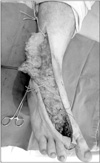Abstract
Macrodystrophia lipomatosa is a congenital disease characterized by gradual proliferation in the mesenchymal cell, such as fibroadipose tissue. Pathologically, fatty tissue is deposited in the nerve sheath, periosteum, bone marrow, and subcutaneous tissue, contributing to the macrodactyly of the foot. To date, there has not been any report on macrodystrophia lipomatosa of the superficial peroneal nerve in the Korean orthopedic literature. Conservative approach, such as decompression or debulking surgery, is recommended due to neurogenic dysfunction. However, we report a 43-year-old male with macrodystrophia lipomatosa involving the superficial peroneal nerve of the right foot and ankle, who underwent a second toe ray amputation as well as soft tissue and nerve resection.
Figures and Tables
 | Figure 2Radiographs showing interphalangeal and metatarsophalangeal joint arthritis with hypertrophied phalanx and multiple bony spur. |
 | Figure 3Coronal magnetic resonance imaging of the forefoot showing an enlarged superficial peroneal nerve (white arrows). (A) Nerve fascicles of the superficial peroneal nerve are surrounded by fat tissue with high signal intensity within nerve sheath on T1-weighted imaging. T2-weighted image showing fat tissue with intermediate signal intensity (B) and low signal intensity on T2 fat suppressed image (C). |
 | Figure 4Intraoperative photograph showing medial dorsal cutaneous branch of the superficial peroneal nerve, which was hypertrophied with fatty tissue. |
References
1. Moran V, Butler F, Colville J. X-ray diagnosis of macrodystrophia lipomatosa. Br J Radiol. 1984; 57:523–525.
2. Khan RA, Wahab S, Ahmad I, Chana RS. Macrodystrophia lipomatosa: four case reports. Ital J Pediatr. 2010; 36:69.
3. Ho CA, Herring JA, Ezaki M. Long-term follow-up of progressive macrodystrophia lipomatosa. A report of two cases. J Bone Joint Surg Am. 2007; 89:1097–1102.
4. Fransen BL, Broeders MG, van Oosterom FJ, Gilhuijs ND, Burger BJ. Operative resection is a viable treatment of macrodactyly of the foot caused by lipofibromatous hamartoma: a case study with 5 year follow-up. Foot Ankle Surg. 2014; 20:e47–e50.
5. Goldman AB, Kaye JJ. Macrodystrophia lipomatosa: radiographic diagnosis. AJR Am J Roentgenol. 1977; 128:101–105.
6. Dhinsa BS, Lidder S, Abbasian A. Atypical presentation of fibrolipomatous hamartoma of superficial peroneal nerve. J Foot Ankle Surg. 2016; 55:1067–1068.
7. Çelebi F, Karagulle K, Oner AY. Macrodystrophia lipomatosa of the foot: a case report. Oncol Lett. 2015; 10:951–953.
8. Lee MJ, Kim DR. Recurred macrodystrophia lipomatosa of the foot: a case report. J Korean Foot Ankle Soc. 2016; 20:32–35.
9. Razzaghi A, Anastakis DJ. Lipofibromatous hamartoma: review of early diagnosis and treatment. Can J Surg. 2005; 48:394–399.
10. Brodwater BK, Major NM, Goldner RD, Layfield LJ. Macrodystrophia lipomatosa with associated fibrolipomatous hamartoma of the median nerve. Pediatr Surg Int. 2000; 16:216–218.




 PDF
PDF ePub
ePub Citation
Citation Print
Print





 XML Download
XML Download